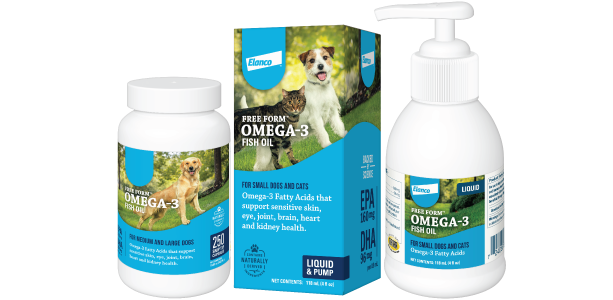Benefits of omega fatty acids for pets.
Fatty acids are the smaller subunits of fat; the most well-known are omega-3 and omega-6. A pet’s body cannot produce most omega fatty acids on its own, but supplementing them can help harness their health benefits.
Linoleic is an omega-6 fatty acid found in plant oils, whereas arachidonic acid is common in animal fats. The omega-3 fatty acids eicosapentaenoic acid (EPA) and docosahexaenoic acid (DHA) are found in fish oil supplements. These omega-6 and omega-3 fatty acids play a role in almost every aspect of pet health.
How Fatty Acids Could Benefit Your Pet
Omega-3 and omega-6 fatty acids have specific functions in your pet’s body:
- The omega-6 fatty acids support normal reproduction and growth, as well as healthy skin.1 -2
- Omega-3 fatty acids support development of healthy nervous tissue and help maintain a normal immune response.3 -4
- The omega-3 fatty acid DHA has been shown to support puppy trainability.5 ,6
- EPA, another important omega-3 fatty acid, has been shown to help promote joint health, flexibility and mobility, and reduce inflammation due to normal activity.7 -8 ,9 ,10
The Role of Fatty Acids in Normal Inflammation
Despite having similar names, omega-6 and omega-3 fatty acids have very different jobs when it comes to a normal inflammatory response. Omega-6 fatty acids begin the inflammatory cascade to combat infection or tissue injury, while the omega-3s, EPA and DHA, are needed to help decrease normal inflammatory pathways. The balance of omega-6 and omega-3 fatty acids is what helps maintain the body’s proper inflammatory response.11 -12
Omega-3 Fatty Acids for Dogs and Cats
Veterinarians may recommend omega-3 supplements with high levels of EPA and DHA to maintain normal inflammatory response and help support normal body functions in dogs and cats. For example:
- Omega-3 fatty acids help support a normal inflammatory response in the skin and may be used to support pets with seasonal allergies.13 -14
- Omega-3 fatty acids may be used to maintain an aging pet’s normal kidney and cardiovascular functions.15 ,16 -17
- Studies show that omega-3 fatty acids are important for supporting everyday activity and healthy joints.18 ,19 ,20
What You Need to Know about Fish Oil Supplements
High-quality fish oil supplements can provide your pet with omega-3 fatty acids. However, before you purchase a fish oil product for your dog or cat, it’s important to talk to your veterinarian.
Your veterinarian will be able to recommend:
- A quality product with a high amount of EPA and DHA
- A safe and effective dose to give your individual pet
1 Gross KL, Yamka RM, Khoo C, et al. Macronutrients. In: Hand MS, Thatcher CD, Remillard RL, et al, eds. (2010). Small Animal Clinical Nutrition. Topeka, KS; Mark Morris Institute; 96-105.
2 Saker KE. (2006). Vet Clin North Am Small Anim Pract. 36(6):1199-1224.
3 Gross KL, Yamka RM, Khoo C, et al. Macronutrients. In: Hand MS, Thatcher CD, Remillard RL, et al, eds. (2010). Small Animal Clinical Nutrition. Topeka, KS; Mark Morris Institute; 96-105.
4 Zicker SC, Jewell DE, Yamka RM, et al. (2012). JAVMA. 241(5):583-594.
5 Heinemann KM, Bauer JE. (2006). JAVMA. 228(5):700-705.
6 Zicker SC, Jewell DE, Yamka RM, et al. (2012). JAVMA. 241(5):583-594.
7 Gross KL, Yamka RM, Khoo C, et al. Macronutrients. In: Hand MS, Thatcher CD, Remillard RL, et al, eds. (2010). Small Animal Clinical Nutrition. Topeka, KS; Mark Morris Institute; 96-105.
8 Bauer JE. (2011). JAVMA. 239(11):1441-1451.
9 Curtis CL, Hughes CE, Flannery CR, et al. (2000). J Biol Chem. 275(2):721-724.
10 Budsberg SC, Bartges JW. (2006). Vet Clin North Am Small Anim Pract. 36(6):1307-1323.
11 Gross KL, Yamka RM, Khoo C, et al. Macronutrients. In: Hand MS, Thatcher CD, Remillard RL, et al, eds. (2010). Small Animal Clinical Nutrition. Topeka, KS; Mark Morris Institute; 96-105.
12 Saker KE. (2006). Vet Clin North Am Small Anim Pract. 36(6):1199-1224.
13 Gross KL, Yamka RM, Khoo C, et al. Macronutrients. In: Hand MS, Thatcher CD, Remillard RL, et al, eds. (2010). Small Animal Clinical Nutrition. Topeka, KS; Mark Morris Institute; 96-105.
14 Saker KE. (2006). Vet Clin North Am Small Anim Pract. 36(6):1199-1224.
15 Bauer JE. (2011). JAVMA. 239(11):1441-1451.
16 Brown SA, Finco DR, Brown CA. (1998). J Nutr. 128(12)(suppl):2765S-2767S.
17 Smith CE, Freeman LM, Rush JE, et al. (2007). J Vet Intern Med. 21(2):265-273.
18 Bauer JE. (2011). JAVMA. 239(11):1441-1451.
19 Curtis CL, Hughes CE, Flannery CR, et al. (2000). J Biol Chem. 275(2):721-724.
20 Budsberg SC, Bartges JW. (2006). Vet Clin North Am Small Anim Pract. 36(6):1307-1323.

Free Form™ Omega-3 Fish Oil for Dogs & Cats
A supplement for dogs and cats that supports the health of your pet’s skin and coat, joints and immune system with highly concentrated, omega-3 fatty acids. And it comes in two convenient forms so you can choose the one that’s right for your pet, no prescription required.





